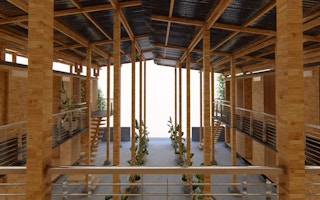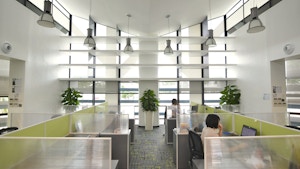As sustainable building technologies evolve, so does the hype around them: hundreds of products and services for today’s urban building industry are marketed as “green”, with much publicity given to properties such as energy efficiency, low carbon footprint, and even air or water purification. But how sustainable are these products and services, really?
Eco-Business asked industry experts to weigh in on four urban solutions that have been making the news: alternative construction materials, green walls, smart or solar windows, and air purifying paints.
1. Bamboo as an alternative construction material
Last year, a materials engineer in the Philippines, Earl Forlales, won the 2018 Cities for our Future competition with a low-cost modular housing design made from bamboo. International judges considered it highly viable as a solution for chronic housing shortages in the Philippines, and Forlales has already started a business to manufacture the houses of his design.
While bamboo is a sustainable material common to this region, it comes with its own challenges.
“The use of bamboo is widely debated in the construction industry,” says Martin Gui, group managing director of interior fit-out firm Facility Link. “Within an office setting, where maintenance and proper cleaning is regularly scheduled, [the use of bamboo in construction] is not usually a problem, but in areas of high traffic and heavy wear and tear, it can become a problem.”
Professor Erwin Viray, head of architecture and sustainable design at the Singapore University of Technology and Design (SUTD), is more optimistic. His colleagues at the university’s Architectural Intelligence Research Laboratory have been researching the viability of bamboo in construction, and have successfully experimented with outdoor structures using bamboo struts held together with 3D printed joints.
There is potential to take their designs and methods further, he says: “Construction [with bamboo] can be more effective today, now that we have technology that can scan each individual bamboo segment and custom-print the other components of the structure with great precision.”
2. Green walls
Green walls, or vertical landscaping, have become so ubiquitous around the world, and their designs so sophisticated, that some cities’ green walls are listed in tourist guides.
In Singapore, the Urban Redevelopment Authority’s LUSH (Landscaping for Urban Spaces and High Rises) programme introduced incentives in 2017 for developers and building owners to incorporate green walls into their developments.
In practice, green walls are not just attractive but have physical and mental health benefits that are difficult to quantify, says Dave Mackerness, who handles asset management for air conditioning service provider Kaer.
“If you look at the evolution of buildings to encompass sustainability, the next step is going to be healthy buildings. You need to consider how the working environment affects people’s cognitive function and their ability to get their work done. Once you factor that in, green walls are not just decorative. They are an enormous benefit to the people using the building.”
The cost of installing and maintaining green walls – which includes the cleaning and botanical care associated with the plants – has also fallen over time, says SUTD’s Viray. “The assembly and maintenance were originally quite challenging, but with each iteration they become more efficient,” he notes, pointing to how the design of vertical landscaping has evolved over time to maximise energy and water efficiency while minimising the amount of care needed for the plants.
3. Smart windows and solar windows
Almost every year, there is hype about some new technology that gives glass windows improved electrochromic properties (darkening or lightening when a current is run through them), or allows windows to generate solar energy, or otherwise.
However, little actual data is available for the performance of such windows in Singapore’s context, possibly because the technology is not widespread, and industry experts are cautious with their assessments.
“Smart or solar windows do help with insulation, temperature and environmental control, and sound control,” says Viray. “However, we need to be mindful of the performance in relation to the environment. In Singapore’s equatorial climate, the humidity and temperature will make a big difference to the effectiveness of these installations. We cannot apply these technologies as they are applied in other countries.”
4. Coatings with air purifying properties
A great many wall paints these days are marketed as having air purifying qualities, usually by absorbing volatile organic compounds (VOCs), chemicals emitted as gases that can have harm human health, and other contaminants from the surrounding air.
Researchers and industry bodies here, like their counterparts in Europe, are sceptical about the claims of these products, with some studies even suggesting that such coatings may release more toxic substances in the long term than they absorb.
Facility Link’s Martin Gui and Tan Phay Ping, managing director of Building System and Diagnostics, both say that coatings proven to improve the indoor air quality are not commonplace.
“While in theory this would be a very useful development, this is at most a promising solution at the moment as there have not been enough installations to verify its efficacy,” Gui says.
Rather than relying on such coatings, he strongly recommends addressing VOC contamination at its root source by selecting building and fit-out materials that release little to no chemical previously trapped gaseous chemicals, and conducting post-construction flushes of premises before they go into use.
A credible benchmark for certified green building products can be certification programmes such as the Singapore Green Building Product (SGBP) certification scheme, which considers criteria such as energy and water savings, human health and wellbeing as well as end-of-life disposal.
According to Owen Wee, SGBC’s Board Technical Coordinator who oversees the SGBP programme and its directory of green products, common criteria across building products undergoing the certification scheme typically include effects on human health and resource savings.
For example, architectural products are mainly assessed for their toxicity and emissions, while mechanical and electrical systems are evaluated based on energy and water efficiency. Products that are able to meet the rigorous criteria that measures long-term sustainability will be awarded the SGBP 4-ticks Leader rating, the highest possible.
“While there are definitely exceptions, product manufacturers or suppliers typically do not focus on detailed carbon emissions reports, end-of-life disposal or upcycling,” he says. “There is definitely room to enhance the scheme further to encourage the industry to shift towards decarbonisation and safeguarding human health.”















